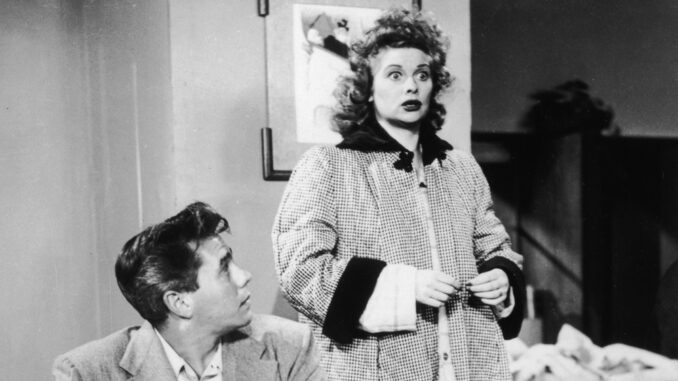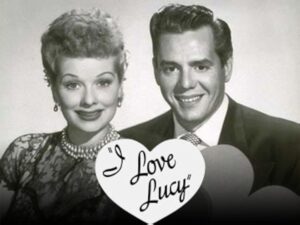
In October 1951, television history was made when the first episode of I Love Lucy aired on CBS. This show, starring Lucille Ball and Desi Arnaz, went on to become one of the most beloved sitcoms of all time. But what did critics think of the pilot when it first aired? The Hollywood Reporter (THR) was among the first to publish a review of the show, capturing the public’s initial reaction to this soon-to-be cultural phenomenon. Let’s dive into THR’s 1951 review of the I Love Lucy first episode, and why it remains an important piece of television history.
The First Episode of ‘I Love Lucy’: A Bold Introduction to a New Era in TV
The pilot episode of I Love Lucy marked a significant turning point in television. At the time, sitcoms were still in their infancy, and very few shows had the staying power or appeal that could captivate such a wide audience. THR’s review of the first episode was positive, noting that the unique chemistry between Lucille Ball and Desi Arnaz set the show apart from others.
A Revolutionary Sitcom Format
In 1951, TV was still evolving, and most sitcoms were filmed live or in front of a small audience. However, I Love Lucy took a different approach.
Three-Camera Setup: A Game-Changer
The three-camera setup used in I Love Lucy was revolutionary for its time. This allowed for a dynamic filming style, capturing multiple angles at once, making scenes feel more natural and lively. THR highlighted how this setup elevated the comedic timing, giving the show a professional polish that most other sitcoms lacked.
Lucille Ball’s Iconic Performance

The Birth of TV’s Funniest Leading Lady
Lucille Ball’s performance in the first episode was nothing short of extraordinary. THR lauded her comedic timing, physical humor, and the way she brought her character, Lucy Ricardo, to life. Ball’s portrayal of the mischievous housewife who often found herself in hilarious situations immediately connected with audiences.
A Physical Comedy Masterclass
Ball’s use of physical comedy, especially in the famous scene where Lucy struggles to keep up with a conveyor belt of chocolates, set the tone for what audiences could expect from the series. THR noted that her ability to make audiences laugh with just a gesture or expression was a rare gift that would keep viewers coming back week after week.
Desi Arnaz: The Perfect Foil
A Cuban Band Leader with Comic Flair
While Lucille Ball often gets most of the credit for I Love Lucy’s success, Desi Arnaz’s role as Ricky Ricardo was equally vital. THR praised Arnaz for his ability to play the straight man to Ball’s wild antics, while also adding his own comedic flair. His character, a Cuban bandleader with dreams of making it big, provided a perfect contrast to Lucy’s scheming nature.
A Trailblazing On-Screen Couple
The fact that I Love Lucy featured an interracial couple (Ball and Arnaz were married in real life) was groundbreaking for its time. THR’s review highlighted how the show subtly broke barriers by showcasing a loving and relatable relationship between a Caucasian woman and a Cuban man, something that was rarely seen on television in the 1950s.
The Supporting Cast: Adding Extra Layers of Comedy

The supporting characters in I Love Lucy also received praise from THR. Vivian Vance and William Frawley, who played Ethel and Fred Mertz, added another layer of humor to the show. Their roles as the Ricardos’ quirky landlords provided perfect comedic relief and complemented the main characters brilliantly.
Ethel and Fred: The Unsung Heroes
Vance and Frawley’s chemistry was noted in the review as a standout element. Ethel’s constant bickering with Fred, combined with her camaraderie with Lucy, gave the show its multi-dimensional comedic punch. THR predicted that these characters would become fan favorites, and they were right.
How THR Predicted ‘I Love Lucy’s’ Long-Term Success
One of the most interesting aspects of THR’s 1951 review was its prediction about the show’s future. Even after just one episode, critics believed that I Love Lucy had the potential to become a long-running hit.
A Show That Broke Barriers
The review recognized the show’s unique ability to appeal to a broad audience, from young children to older adults. It wasn’t just another run-of-the-mill sitcom; it was something special. The combination of strong performances, witty writing, and innovative filming techniques made it a game-changer.
The Impact of ‘I Love Lucy’ on Television History
A Cultural Icon is Born
As THR predicted, I Love Lucy didn’t just become a hit—it became a cultural icon. Over the years, the show has been lauded as one of the greatest sitcoms of all time, influencing countless shows that came after it. From its pioneering filming techniques to its bold comedic performances, the show left an indelible mark on television history.
Conclusion: Why the 1951 THR Review Still Matters
THR’s 1951 review of the I Love Lucy pilot episode remains a significant piece of television history. It not only captured the excitement and innovation of the show but also predicted its lasting impact. Over 70 years later, I Love Lucy continues to entertain new generations, proving that great comedy—and great television—truly stands the test of time.
